#long crested myna
Explore tagged Tumblr posts
Text

Aptrill Day 11: Long-crested Myna.
Reference Photo
35 notes
·
View notes
Text




More birds for Aptrill, I wanted to do all the prompts but I've decided once April is over I won't be posting anymore of the prompts. Hopefully I can do some more tomorrow, but if I can't it's okay. Going into this I knew I wouldn't be able to keep up but I wanted to do it for fun.
#aptrill#birds#eastern yellow robin#long-crested myna#orange-breasted falcon#yellow-billed cuckoo#my art
8 notes
·
View notes
Photo

A new variant has been added!
Long-crested Myna (Basilornis corythaix) © Joseph Wolf
It hatches from black, glossy, limited, metallic, pale, raucous, separate, small, tall, unique, unmistakable, vertical, whitish, and wooded eggs.
squawkoverflow - the ultimate bird collecting game 🥚 hatch ❤️ collect 🤝 connect
4 notes
·
View notes
Text

You thought the starlings were done? NO! Here's the starling rainbow finally put together :D
And if you want to know the species, here is each bird linking to their eBird page: the Bali myna (CR), the rosy starling, the golden myna, the emerald starling, the greater blue-eared starling, the violet-backed starling and the common/European starling.
I guess this replaces the bird-of-the-day for today?
Because starlings are amazing and incredibly diverse as a family, here's some more cool looking ones that couldn't fit into the rainbow:
Superb starling (LC) image source

Golden-breasted starling (LC) image source

Wattled starling (LC) image source

Long-crested myna (LC) image source

Indian pied starling (LC) image source

#rainbow#birds#no i didnt post this accidentally on my personal blog what no never#bird art#birdblr#ornithology#artists on tumblr#digital art#starlings#starling#sturnidae#animal art
87 notes
·
View notes
Text
Alrighty and HERE ARE OUR CONTENDERS!!!
Tag for the polls: #bird battle
DISCLAIMER - I wrote the round one blurbs when I was very sick and half awake, so if you see any mistakes PLEASE TELL ME! Nicely, obviously, but I want to make sure they sound good for round 2. Thank you!
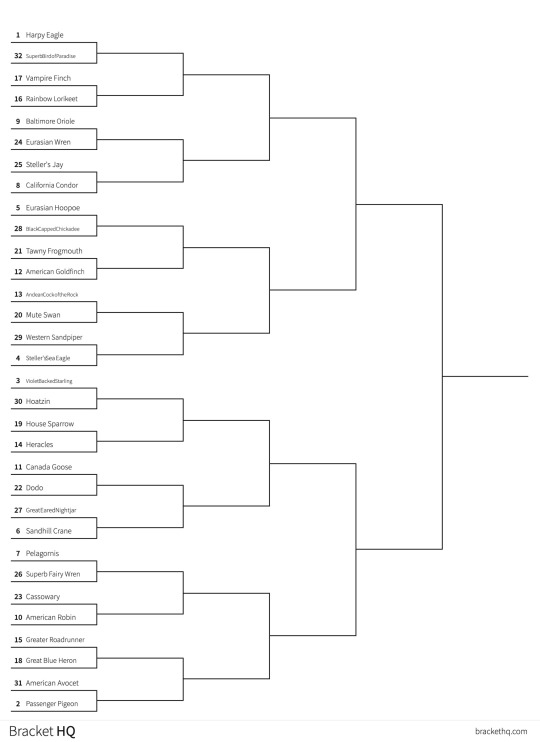

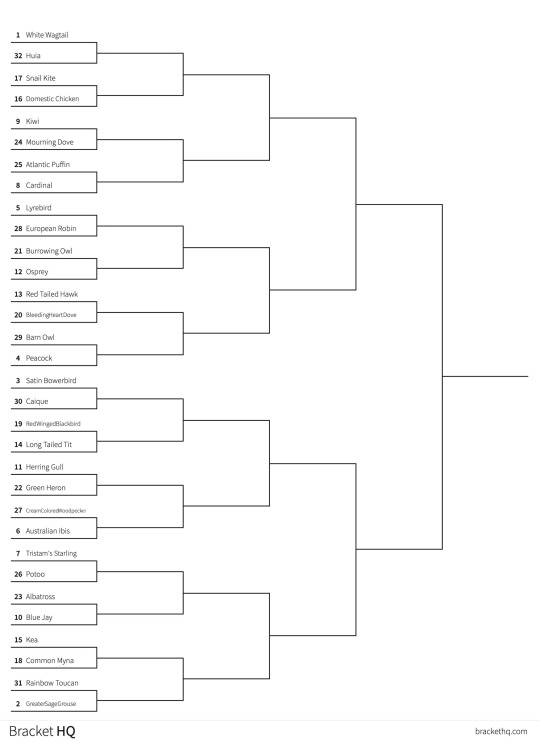

I know there’s a lot of them, but man there’s SO MANY GOOD BIRDS! There were a few times where people didn’t put what specific subspecies for some birds, so sometimes I’d have to choose one. I tried to choose one that represents that bird the best!
I don’t know when the polls will begin, I’m doing some research on the birds so that people can read about them before they vote.
If one of your favs didn’t make it in, don’t worry they’re a winner in my and your heart.
If you are wondering where the Pigeon (Rock Dove) is, THEY ARE THE FINAL CHAMPION! At the end of this bracket, the winner will face off against the mightily popular Rock Dove! Will they be able to beat such a tough challenger? We will see…
Also, a note on how I set this bracket up: I put all the birds in a numbered list and then used a number generator. I think the matchups we got were really interesting.
Full list under the cut
HARPY EAGLE
SUPERB BIRD OF PARADISE
VAMPIRE FINCH
RAINBOW LORIKEET
BALTIMORE ORIOLE
EURASIAN WREN
STELLER'S JAY
CALIFORNIA CONDOR
EURASIAN HOOPOE
BLACK CAPPED CHICKADEE
TAWNY FROGMOUTH
AMERICAN GOLDFINCH
ANDEAN COCK OF THE ROCK
MUTE SWAN
WESTERN SANDPIPER
STELLER'S SEA EAGLE
VIOLET BACKED STARLING
HOATZIN
HOUSE SPARROW
HERACLES
CANADIAN GOOSE
DODO
GREAT EARED NIGHTJAR
SANDHILL CRANE
PELAGORNIS
SUPERB FAIRY WREN
SOUTHERN CASSOWARY
AMERICAN ROBIN
GREATER ROADRUNNER
GREAT BLUE HERON
AMERICAN AVOCET
PASSENGER PIGEON
WALLCREEPER
GREAT TIT
MOA
EASTERN BLUEBIRD
AUSTRALIAN BUSHTURKEY
EMU
MALLARD DUCK
FLAME BOWERBIRD
MANDARIN DUCK
BELTED KINGFISHER
OILBIRD
FAIRY PENGUIN
LESSER FLAMINGO
AUSTRALIAN KESTREL
CARRION CROW
UMBRELLABIRD
LOGGERHEAD SHRIKE
PERUVIAN PELICAN
CALIFORNIA QUAIL
MACGREGORS BOWERBIRD
HARRIS HAWK
COMMON RAVEN
BEARDED VULTURE
PEREGRINE FALCON
ROSY LOVEBIRD
ROSEATTE SPOONBILL
LONG TAILED GRACKLE
AMERICAN WOODCOCK
KAKAPO
BLUE FOOTED BOOBY
RHEA
BEE HUMMINGBIRD
WHITE WAGTAIL
HUIA
SNAIL KITE
DOMESTIC CHICKEN
KIWI
MOURNING DOVE
ATLANTIC PUFFIN
CARDINAL
LYREBIRD
EUROPEAN ROBIN
BURROWING OWL
OSPREY
RED TAILED HAWK
BLEEDING HEART DOVE
BARN OWL
PEACOCK
SATIN BOWERBIRD
CAIQUE
RED WINGED BLACKBIRD
LONG TAILED TIT
HERRING GULL
GREEN HERON
CREAM COLORED WOODPECKER
AUSTRALIAN IBIS
TRISTAM'S STARLING
POTOO
WANDERING ALBATROSS
BLUE JAY
KEA
COMMON MYNA
RAINBOW TOUCAN
GREATER SAGE GROUSE
TURKEY VULTURE
TUFTED TITMOUSE
CRESTED AUKLET
EURASIAN MAGPIE
BUDGIE
SCREECH OWL
WIP-POOR-WILL
SECRETARY BIRD
AUSTRALIAN MAGPIE
CEDAR WAXWING
VICTORIA CROWNED PIGEON
HERMIT THRUSH
COMMON SWIFT
WHITE BELLBIRD
BROWN SKUA
EUROPEAN DIPPER
111 notes
·
View notes
Text
All animal species (and a couple algae) that have kept the same scientific name since Linnaeus
The first work of taxonomy that is considered as having any scientific authority for animal species was the 10th edition of Linnaeus' Systema Naturae, published in 1758. (Also a book on spiders called Aranei Suecici, published one year before.) That's the foundational text of the binominal system of nomenclature of species still in use today. Since then most of Linnaeus' original species (4379 species, of which 185 mammals, 554 birds, 217 "amphibians" (including reptiles and cartilaginous fish), 379 fishes, 2104 "insects" (including various arthropods, of which 664 are beetles and 543 are moths & butterflies crammed into only 3 genera), and 940 "worms" (including basically all other invertebrates, and even some protists and algae)) have been dismembered, renamed, or at least moved to different genera (e.g. the house sparrow went from Fringilla domestica to Passer domesticus).
Here is a list of all of Linnaeus' original species from 1758 that still retain their original name. I believe they are 484 in total.
"Mammalia"
(Primates)
Homo sapiens (human)
Lemur catta (ring-tailed lemur)
Vespertilio murinus (rearmouse bat)
(Bruta)
Elephas maximus (Asian elephant)
Trichechus manatus (West Indian manatee)
Bradypus tridactylus (three-toed sloth)
Myrmecophaga tridactyla (giant anteater)
Manis pentadactylus (Chinese pangolin)
(Ferae)
Phoca vitulina (harbor seal)
Canis familiaris (dog)
Canis lupus (grey wolf)
Felis catus (house cat)
Viverra zibetha (Indian civet)
Mustela erminea (stoat)
Mustela furo (ferret)
Mustela lutreola (European mink)
Mustela putorius (wild ferret)
Ursus arctos (brown bear)
(Bestiae)
Sus scrofa (wild boar/pig)
Dasypus septemcinctus (seven-banded armadillo)
Dasypus novemcinctus (nine-banded armadillo)
Erinaceus europaeus (European hedgehog)
Talpa europaea (European mole)
Sorex araneus (common shrew)
Didelphis marsupialis (common opossum)
(Glires)
Rhinoceros unicornis (Indian rhinoceros)
Hystrix brachyura (Malayan porcupine)
Hystrix cristata (crested porcupine)
Lepus timidus (common hare)
Castor fiber (European beaver)
Mus musculus (house mouse)
Sciurus vulgaris (red squirrel)
(Pecora)
Camelus dromedarius (dromedary camel)
Camelus bactrianus (Asian camel)
Moschus moschiferus (musk deer)
Cervus elaphus (red deer)
Capra hircus (goat)
Capra ibex (Alpine ibex)
Ovis aries (sheep)
Bos taurus (cow)
Bos indicus (zebu)
(Belluae)
Equus caballus (horse)
Equus asinus (donkey)
Equus zebra (mountain zebra)
Hippopotamus amphibius (hippopotamus)
(Cete)
Monodon monoceros (narwhal)
Balaena mysticetus (bowhead whale)
Physeter macrocephalus (sperm whale)
Delphinus delphis (common dolphin)
"Aves"
(Accipitres)
Vultur gryphus (Andean condor)
Falco tinnunculus (common kenstrel)
Falco sparverius (sparrowhawk)
Falco columbarius (pigeonhawk)
Falco subbuteo (Eurasian hobby)
Falco rusticolus (gyrfalcon)
Strix aluco (tawny owl)
Lanius excubitor (great grey shrike)
Lanius collurio (red-backed shrike)
Lanius schach (long-tailed shrike)
(Picae)
Psittacus erithacus (grey parrot)
Ramphastos tucanus (white-throated toucan)
Buceros bicornis (great hornbill)
Buceros rhinoceros (rhinoceros hornbill)
Crotophaga ani (smooth-billed ani)
Corvus corax (raven)
Corvus corone (carrion crow)
Corvus frugilegus (rook)
Corvus cornix (hooded crow)
Coracias oriolus (golden oriole)
Coracias garrulus (European roller)
Gracula religiosa (hill myna)
Paradisaea apoda (greater bird-of-paradise)
Cuculus canorus (common cuckoo)
Jynx torquilla (wryneck)
Picus viridis (green woodpecker)
Sitta europaea (Eurasian nuthatch)
Merops apiaster (European bee-eater)
Merops viridis (blue-throated bee-eater)
Upupa epops (Eurasian hoopoe)
Certhia familiaris (Eurasian treecreeper)
Trochilus polytmus (red-billed streamertail hummingbird)
(Anseres)
Anas platyrhynchos (mallard duck)
Anas crecca (teal duck)
Mergus merganser (common merganser)
Mergus serrator (red-breasted merganser)
Alca torda (razorbill auk)
Procellaria aequinoctialis (white-chinned petrel)
Diomedea exulans (wandering albatross)
Pelecanus onocrotalus (great white pelican)
Phaeton aethereus (red-billed tropicbird)
Larus canus (common gull)
Larus marinus (great black-backed gull)
Larus fuscus (lesser black-backed gull)
Sterna hirundo (common tern)
Rhynchops niger (black skimmer)
(Grallae)
Phoenicopterus ruber (American flamingo)
Platalea leucorodia (Eurasian spoonbill)
Platalea ajaia (roseate spoonbill)
Mycteria americana (wood stork)
Ardea cinerea (grey heron)
Ardea herodias (blue heron)
Ardea alba (great egret)
Scolopax rusticola (Eurasian woodcock)
Charadrius hiaticula (ringed plover)
Charadrius alexandrinus (Kentish plover)
Charadrius vociferus (killdeer plover)
Charadrius morinellus (Eurasian dotterel)
Recurvirostra avosetta (pied avocet)
Haematopus ostralegus (Eurasian oystercatcher)
Fulica atra (Eurasian coot)
Rallus aquaticus (water rail)
Psophia crepitans (grey-winged trumpeter)
Otis tarda (great bustard)
Struthio camelus (ostrich)
(Gallinae)
Pavo cristatus (Indian peafowl)
Meleagris gallopavo (wild turkey)
Crax rubra (great curassow)
Phasianus colchicus (common pheasant)
Tetrao urogallus (western capercaillie)
(Passeres)
Columba oenas (stock dove)
Columba palumbus (wood pigeon)
Alauda arvensis (Eurasian skylark)
Sturnus vulgaris (European starling)
Turdus viscivorus (mistle thrush)
Turdus pilaris (fieldfare thrush)
Turdus iliacus (redwing thrush)
Turdus plumbeus (red-legged thrush)
Turdus torquatus (ring ouzel)
Turdus merula (blackbird)
Loxia curvirostra (crossbill)
Emberiza hortulana (ortolan bunting)
Emberiza citrinella (yellowhammer)
Emberiza calandra (corn bunting)
Fringilla coelebs (common chaffinch)
Motacilla alba (white wagtail)
Motacilla lava (yellow wagtail)
Parus major (great tit)
Hirundo rustica (barn swallow)
Caprimulgus europaeus (European nightjar)
"Amphibia"
(Reptiles)
Testudo graeca (Greek tortoise)
Draco volans (flying dragon)
Lacerta agilis (sand lizard)
Rana temporaria (common frog)
(Serpentes)
Crotalus horridus (timber rattlesnake)
Crotalus durissus (tropical rattlesnake)
Boa constrictor (common boa)
Coluber constrictor (eastern racer)
Anguis fragilis (slowworm)
Amphisbaena alba (red worm lizard)
Caecilia tentaculata (white-bellied caecilian)
(Nantes)
Petromyzon marinus (sea lamprey)
Raja clavata (thornback ray)
Raja miraletus (brown ray)
Squalus acanthias (spiny dogfish)
Chimaera monstrosa (rabbitfish)
Lophius piscatorius (anglerfish)
Acipenser sturio (sea sturgeon)
Acipenser ruthenus (sterlet sturgeon)
"Pisces"
(Apodes)
Muraena helena (Mediterranean moray)
Gymnotus carapo (banded knifefish)
Trichiurus lepturus (cutlassfish)
Anarhichas lupus (Atlantic wolffish)
Ammodytes tobianus (lesser sandeel)
Xiphias gladius (swordfish)
Stromateus fiatola (blue butterfish)
(Jugulares)
Callionymus lyra (common dragonet)
Uranoscopus scaber (stargazer)
Trachinus draco (greater weever)
Gadus morhua (Atlantic cod)
Blennius ocellaris (butterfly blenny)
Ophidion barbatum (snake cusk-eel)
(Thoracici)
Cyclopterus lumpus (lumpsucker)
Echeneis naucrates (sharksucker)
Coryphaena equiselis (pompano)
Coryphaena hippurus (dorado)
Gobius niger (black goby)
Govius paganellus (rock goby)
Cottus gobio (European bullhead)
Scorpaena porcus (black scorpionfish)
Scorpaena scrofa (red scorpionfish)
Zeus faber (John Dory)
Pleuronectes platessa (European plaice)
Chaetodon striatus (banded butterflyfish)
Chaetodon capistratus (foureye butterflyfish)
Sparus aurata (gilt-head bream)
Labrus merula (brown wrasse)
Labrus mixtus (cuckoo wrasse)
Labrus viridis (green wrasse)
Sciaena umbra (brown meagre)
Perca fluviatilis (European perch)
Gasterosteus aculeatus (three-spined stickleback)
Scomber scombrus (Atlanti mackerel)
Mullus barbatus (red mullet)
Mullus surmuletus (surmullet)
Trigla lyra (piper gurnard)
(Abdominales)
Cobitis taenia (spined loach)
Silurus asotus (Amur catfish)
Silurus glanis (Wels catfish)
Loricaria cataphracta (suckermouth catfish)
Salmo carpio (Garda trout)
Salmo trutta (brown trout)
Salmo salar (Atlantic salmon)
Fistularia tabacaria (bluespotted cornetfish)
Esox lucius (northern pike)
Argentina sphyraena (European argentine)
Atherina hepsetus (Mediterranean sand smelt)
Mugil cephalus (flathead mullet)
Exocoetus volitans (tropical flying fish)
Polynemus paradiseus (Paradise threadfin)
Clupea harengus (Atlantic herring)
Cyprinus carpio (common carp)
(Branchiostegi)
Mormyrus caschive (bottlenose elephantfish)
Balistes vetula (queen triggerfish)
Ostracion cornutus (longhorn cowfish)
Ostracion cubicus (yellow boxfish)
Tetraodon lineatus (Fahaka pufferfish)
Diodon hystrix (spot-fin porcupinefish)
Diodon holocanthus (long-spine porcupinefish)
Centriscus scutatus (grooved shrimpfish)
Syngnathus acus (common pipefish)
Syngnathus pelagicus (pelagic pipefish)
Syngnathus typhle (broad-nosed pipefish)
Pegasus volitans (longtail seamoth)
"Insecta"
(Coleoptera)
Scarabaeus sacer (sacred scarab)
Dermestes lardarius (larder beetle)
Dermestes murinus (larder beetle)
Hister unicolor (clown beetle)
Hister quadrimaculatus (clown beetle)
Silpha obscura (carrion beetle)
Cassida viridis (tortoise beetle)
Cassida nebulosa (tortoise beetle)
Cassida nobilis (tortoise beetle)
Coccinella trifasciata (ladybug)
Coccinella hieroglyphica (ladybug) [Coccinella 5-punctata, 7-punctata, 11-punctata, and 24-punctata survive as quinquepunctata, septempunctata, undecimpunctata, and vigintiquatorpunctata]
Chrysomela populi (leaf beetle)
Chrysomela lapponica (leaf beetle)
Chrysomela collaris (leaf beetle)
Chrysomela erythrocephala (leaf beetle)
Curculio nucum (nut weevil)
Attelabus surinamensis (leaf-rolling weevil)
Cerambyx cerdo (capricorn beetle)
Leptura quadrifasciata (longhorn beetle)
Cantharis fusca (soldier beetle)
Cantharis livida (soldier beetle)
Cantharis oscura (soldier beetle)
Cantharis rufa (soldier beetle)
Cantharis lateralis (soldier beetle)
Elater ferrugineus (rusty click beetle)
Cicindela campestris (green tiger beetle)
Cicindela sylvatica (wood tiger beetle)
Buprestis rustica (jewel beetle) [Buprestis 8-guttata survives as octoguttata]
Dytiscus latissimus (diving beetle)
Carabus coriaceus (ground beetle)
Carabus granulatus (ground beetle)
Carabus nitens (ground beetle)
Carabus hortensis (ground beetle)
Carabus violaceus (ground beetle)
Tenebrio molitor (mealworm)
Meloe algiricus (blister beetle)
Meloe proscarabaeus (blister beetle)
Meloe spec (blister beetle)
Mordela aculeata (tumbling glower beetle)
Necydalis major (longhorn beetle)
Staphylinus erythropterus (rove beetle)
Forficula auricularia (common earwig)
Blatta orientalis (Oriental cockroach)
Gryllus campestris (field cricket)
(Hemiptera)
Cicada orni (cicada)
Notonecta glauca (backswimmer)
Nepa cinerea (water scorpion)
Cimex lectularius (bedbug)
Aphis rumici (black aphid)
Aphis craccae (vetch aphid)
Coccus hesperidum (brown scale insect)
Thrips physapus (thrips)
Thrips minutissimum (thrips)
Thrips juniperinus (thrips)
(Lepidoptera)
Papilio paris (Paris peacock butterfly)
Papilio helenus (red Helen butterfly)
Papilio troilus (spicebush swallowtail butterfly)
Papilio deiphobus (Deiphobus swallowtail butterfly)
Papilio polytes (common Mormon butterfly)
Papilio glaucus (eastern tiger swallowtail butterfly)
Papilio memnon (great Mormon butterfly)
Papilio ulysses (Ulysses butterfly)
Papilio machaon (Old World swallowtail butterfly)
Papilio demoleus (lime swallowtail butterfly)
Papilio nireus (blue-banded swallowtail butterfly)
Papilio clytia (common mime butterfly)
Sphinx ligustri (privet hawk-moth)
Sphinx pinastri (pine hawk-moth) [genus Phalaena was suppressed, but seven subgenera created by Linnaeus are now valid as genera]
(Neuroptera)
Libellula depressa (chaser dragonfly)
Libellula quadrimaculata (four-spotted skimmer dragonfly)
Ephemera vulgata (mayfly)
Phryganea grandis (caddisfly)
Hemerobius humulinus (lacewing)
Panorpa communis (scorpionfly)
Panorpa germanica (scorpionfly)
Raphidia ophiopsis (snakefly)
(Hymenoptera)
Cynips quercusfolii (oak gall wasp)
Tenthredo atra (sawfly)
Tenthredo campestris (sawfly)
Tenthredo livida (sawfly)
Tenthredo mesomela (sawfly)
Tenthredo scrophulariae (sawfly)
Ichneumon extensorius (parasitoid wasp)
Ichneumon sarcitorius (parasitoid wasp)
Sphex ichneumoneus (digger wasp)
Vespa crabro (European hornet)
Apis mellifera (honey bee)
Formica fusca (silky ant)
Mutilla europaea (large velvet ant)
(Diptera)
Oestrus ovis (sheep botfly)
Tipula oleracea (marsh cranefly)
Tipula hortorum (cranefly)
Tipula lunata (cranefly)
Musca domestica (housefly)
Tabanus bovinus (pale horsefly)
Tabanus calens (horsefly)
Tabanus bromius (brown horsefly)
Tabanus occidentalis (horsefly)
Tabanus antarcticus (horsefly)
Culex pipiens (house mosquito)
Empis borealis (dance fly)
Empis pennipes (dance fly)
Empis livida (dance fly)
Conops flavipes (thick-headed fly)
Asilus barbarus (robberfly)
Asilus crabroniformis (hornet robberfly)
Bombylius major (bee fly)
Bombylius medius (bee fly)
Bombylius minor (bee fly)
Hippobosca equina (forest fly)
(Aptera)
Lepisma saccharina (silverfish)
Podura aquatica (water springtail)
Termes fatale (termite)
Pediculus humanus (human louse)
Pulex irritans (human flea)
Acarus siro (flour mite)
Phalangium opilio (harvestman)
Araneus angulatus (orb-weaving spider)
Araneus diadematus (European garden spider)
Araneus marmoreus (marbled orbweaver)
Araneus quadratus (four-spotted orbweaver -- last four are by Clerck 1757, some of the very few surviving pre-Linnean names!)
Scorpio maurus (large-clawed scorpion)
Cancer pagurus (brown crab)
Oniscus asellus (common woodlouse)
Scolopendra gigantea (giant centipede)
Scolopendra morsitans (red-headed centipede)
Julus fuscus (millipede)
Julus terrestris (millipede)
"Vermes"
(Intestina)
Gordius aquaticus (horsehair worm)
Lumbricus terrestris (common earthworm)
Ascaris lumbricoides (giant roundworm)
Fasciola hepatica (liver fluke)
Hirudo medicinalis (medicinal leech)
Myxine glutinosa (Atlantic hagfish)
Teredo navalis (shipworm)
[shout out to Furia infernalis, a terrifying carnivorous jumping worm that Linnaeus described, but which doesn't seem to actually exist]
(Mollusca)
Limax maximus (leopard slug)
Doris verrucosa (warty nudibranch)
Nereis caerulea (ragworm)
Nereis pelagica (ragworm)
Aphrodita aculeata (sea mouse)
Lernaea cyprinacea (anchor worm)
Scyllaea pelagica (Sargassum nudibranch)
Sepia officinalis (common cuttlefish)
Asterias rubens (common starfish)
Echinus esculentus (edible sea urchin)
(Testacea)
Chiton tuberculatus (West Indian green chiton)
Lepas anatifera (goose barnacle)
Pholas dactylus (common piddock)
Mya arenaria (softshell clam)
Mya truncata (truncate softshell)
Solen vagina (razor clam)
Tellina laevigata (smooth tellin)
Tellina linguafelis (cat-tongue tellin)
Tellina radiata (sunrise tellin)
Tellina scobinata (tellin)
Cardium costatum (ribbed cockle)
Donax cuneatus (wedge clam)
Donas denticulatus (wedge clam)
Donax trunculus (wedge clam)
Venus casina (Venus clam)
Venus verrucosa (warty venus)
Spondylus gaederopus (thorny oyster)
Spondylus regius (thorny oyster)
Chama lazarus (jewel box shell)
Chama gryphoides (jewel box shell)
Arca noae (Noah's ark shell)
Ostrea edulis (edible oyster)
Anomia aurita (saddle oyster)
Anomia ephippium (saddle oyster)
Anomia hysterita (saddle oyster)
Anomia lacunosa (saddle oyster)
Anomia spec (saddle oyster)
Anomia striatula (saddle oyster)
Mytilus edulis (blue mussel)
Pinna muricata (pen shell)
Pinna nobilis (fan mussel)
Pinna rudis (rough pen shell)
Argonauta argo (argonaut)
Nautilus pompilius (chambered nautilus)
Conus ammiralis (admiral cone snail)
Conus aulicus (princely cone snail)
Conus aurisiacus (cone snail)
Conus betulinus (betuline cone snail)
Conus bullatus (bubble cone snail)
Conus capitaneus (captain cone snail)
Conus cedonulli (cone snail)
Conus ebraeus (black-and-white cone snail)
Conus figulinus (fig cone snail)
Conus genuanus (garter cone snail)
Conus geographus (geographer cone snail)
Conus glaucus (glaucous cone snail)
Conus granulatus (cone snail)
Conus imperialis (imperial cone snail)
Conus litteratus (lettered cone snail)
Conus magus (magical cone snail)
Conus marmoreus (marbled cone snail)
Conus mercator (trader cone snail)
Conus miles (soldier cone snail)
Conus monachus (monastic cone snail)
Conus nobilis (noble cone snail)
Conus nussatella (cone snail)
Conus princeps (prince cone snail)
Conus spectrum (spectrecone snail)
Conus stercusmuscarum (fly-specked cone snail)
Conus striatus (striated cone snail)
Conus textile (cloth-of-gold cone snail)
Conus tulipa (tulip cone snail)
Conus varius (freckled cone snail)
Conus virgo (cone snail)
Cypraea tigris (tiger cowry shell)
Bulla ampulla (Pacific bubble shell)
Voluta ebraea (Hebrew volute)
Voluta musica (music volute)
Buccinum undatum (common whelk)
Strombus pugilis (fighting conch)
Murex tribulus (caltrop murex)
Trochus maculatus (maculated top shell)
Turbo acutangulus (turban shell)
Turbo argyrostomus (silver-mouth turban shell)
Turbo chrystostomus (gold-mouth turban shell)
Turbo marmoratus (green turban shell)
Turbo petholatus (turban shell)
Turbo sarmaticus (giant turban shell)
Helix lucorum (Mediterranean snail)
Helix pomatia (Roman snail)
Nerita albicilla (blotched nerite)
Nerita chamaeleon (nerite)
Nerita exuvia (snakeskin nerite)
Nerita grossa (nerite)
Nerita histrio (nerite)
Nerita peloronta (bleeding tooth)
Nerita plicata (nerite)
Nerita polita (nerite)
Nerita undata (nerite)
Haliotis asinina (ass-ear abalone)
Haliotis marmorata (marbled abalone)
Haliotis midae (South African abalone)
Haliotis parva (canaliculate abalone)
Haliotis tuberculata (green ormer)
Haliotis varia (common abalone)
Patella caerulea (Mediterranean limpet)
Patella pellucida (blue-rayed limpet)
Patella vulgata (European limpet)
Dentalium elephantinum (elephant tusk)
Dentalium entale (tusk shell)
[genus Serpula is still in use with none of its original species]
(Lithophyta)
Tubipora musica (organ pipe coral)
Millepora alcicornis (sea ginger fire coral)
Madrepora oculata (zigzag stone coral)
(Zoophyta)
Isis hippuris (sea bamboo)
Isis ochracea (sea bamboo)
Gorgonia flabellum (Venus fan)
Gorgonia ventalina (purple sea fan)
Alcyonium bursa (soft coral)
Alcyonium digitatum (dead man's fingers)
Tubularia indivisa (oaten ipes hydroid)
Corallina officinalis (coralline red alga)
Sertularia argentea (sea fern)
Sertularia cupressoides (hydroid)
Pennatula phosphorea (sea pen)
Taenia solium (pork tapeworm)
Volvox globator (colonial alga)
[genus Hydra is still in use with none of its original species]
15 notes
·
View notes
Text
🦚Send in a number + Character and I'll draw them in an outfit based on that bird🦚
Allen's Hummingbird
African Crowned Crane
African Emerald Cuckoo
American Goldfinch
Anna's Hummingbird
Asian Emerald Cuckoo
Asian Koel
Atlantic Puffin
Azure Kingfisher
Bald Eagle
Barn Owl
Barn Swallow
Barred Owl
Bat Falcon
Bearded Vulture
Bee Hummingbird
Black Swan
Blue-And-Yellow Macaw
Blue Crowned Pigeon
Blue-Footed Booby
Blue Jay
Bohemian Waxwing
Brahma Chicken
Broad-Billed Hummingbird
Bronze Fallow Cockatie
Canadian Goose
Cassowary
Cardinal
Common Raven
Coua
Dusky Lory
Diederik Cuckoo
Eastern Brown Pelican
Egret
Emerald Starling
Emperor Penguin
Emu
Eurasian Hoopoe
Eurasian Magpie
European Starling
European Turtle Dove
Flamingo
Frigatebird
Fruit Dove
Galah
Gambel's Quail
Golden-Breasted Starling
Golden Pheasant
Gouldian Finch
Grandala
Great Hornbill
Great Horned Owl
Greater Blue-Eared Starling
Green-Legged Partridge
Gurney’s Pitta
Hawaiian Honeycreepers
Hoatzin
Hooded Crow
Horned Sungem
Hyacinth Macaw
Kadaknath
Kakapo
Keel-Billed Toucan
Lilac-Breasted Roller
Long Tailed Tit
Luzon Bleeding-Heart Dove
Mandarin Duck
Mountain Bluebird
Montezuma quail
Mute Swan
Nicobar Pigeon
Northern Oriole
Painted Bunting
Paradise Tanager
Peafowl (peacock/peahen)
Peregrine Falcon
Pileated Woodpecker
Pink Cockatoo
Rainbow Lorikeet
Red Crested Turaco
Red-Necked Tanager
Resplendent Quetzal
Ribbon-Tailed Astrapia
Ruby-Throated Hummingbird
Scarlet Macaw
Secretary Bird
Snowy Owl
Stork-Billed Kingfisher
Sulphur-Crested Cockatoo
Superb Bird-Of-Paradise
Superb Starling
Victoria Crowned Pigeon
Violetear
Violet-Backed Starling
Violet-Green Swallow
Wood Duck
Wilson's Bird-Of-Paradise
Yellow-Crowned Woodpecker
Yellow-Faced Myna
Zanzibar Red Bishop
7 notes
·
View notes
Text
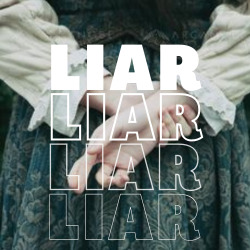
(The winner of the fic poll is Forest of Teeth! Below is an excerpt. I might use the poll system more often!)
Eyes burn at her from all sides. Myna’s skin feels tight and itchy beneath her dress, the soft fabric her brother foisted upon her still too much. She longs to crawl from her own body like a butterfly freeing itself from its cocoon but she stays in her rightful place beside Sansa.
Joffrey’s name day comes with the clang of swords and the whinnying of horses. Men subject themselves to the frivolous yet dangerous sport of jousting for his amusement. Family crests are splattered in mud, the shame of it all grating on Myna’s Northron sensibilities. Playing at war is so strange. Clamoring for the glory of a false battle and begging for the world to look at them even more so.
Every injury only proves her point. She remembers the horrific story of the eldest Tyrell, such a sweet boy becoming crippled by the crushing weight of his own horse against the indomitable Oberon Martell. Her father had told her the story as she practiced her blades, the folly of those men a warning that even the most common of sports can be the thing that kills. Not that the men of the North would play at knight so readily, but the eagerness of performance still strikes an ironic cord.
For the Briarwoods also clamor for their Lord’s attention and play at war for his amusement. Just not so publicly.
#since Forest of Teeth won#here's some of the next chapter!#forest of teeth#enjoy a sloppy edit from canva#myna briarwood#game of thrones fanfiction
5 notes
·
View notes
Text
BRACKET A: FAVES
Pinyon Jay, Bridled Titmouse, Kirtland's Warbler, Dusky Seaside Sparrow, Gray Catbird, Gray Vireo, Rook, Smooth-billed Ani, Toulouse Goose, Pygmy Nuthatch, Blue Nuthatch, Rufous-collared Sparrow, Prothonotary Warbler, Channel-billed Cuckoo, Short-eared Owl, Whiskered Treeswift, Green Catbird, American Dipper, Common Ground Dove, Oilbird, Yellow-billed Magpie, Ferruginous Hawk, Grey warbler [Riroriro], African Penguin, Blakiston’s Fish Owl, Lesser Roadrunner, Great Bustard, European Pied Flycatcher, Bonin Petrel, Band-tailed Manakin, Pallas Sandgrouse, White-throated Magpie-Jay
BRACKET B: TRUE
Regent Honeyeater, Invisible Rail, Palawan Peacock-pheasant, Bald Parrot, Kagu, Azores Bullfinch, Capuchinbird, Zigzag Heron, Writhe-billed Hornbill, Blue-Capped Ifrita, Delalande's coua, Madagascar Ibis, Blue-headed Racquet-tail, Eurasian Three-toed Woodpecker, Glaucous Macaw, Goldie's Bird-of-Paradise, Red-Crested Turaco, Palau Kingfisher, Ribbon-tailed Astrapia, Great Argus, Kaua'i Mole Duck, Whiskered Auklet, Dulit Frogmouth, Naked-faced Barbet, Pink-throated Twinspot, Water Thick-Knee, Cabot's Tragopan, White-tailed Ptarmigan, Collared Nightjar, Sickle-winged Nightjar, Emerald Starling, Starry Owlet-nightjar
BRACKET C: PRETTY
Gouldian Finch, Violet Turaco, Red-tailed Black Cockatoo, Pompadour Cotinga, Pheasant-tailed Jacana, Wilson's Bird-of-Paradise, Purple-crowned Fairy, Painted Redstart, Western Bluebird, Golden Pheasant, Beautiful Nuthatch, Ochre-backed Woodpecker, Chucao Tapaculo, Bohemian Waxwing, Plumed Whistling-Duck, Lady Amherst's Pheasant, Bluethroat, Southern Emuwren, Shaft-tailed Whydah, Green Wood-Hoopoe, Plumbeous Redstart, Long-tailed Minivet, Japanese Paradise flycatcher, Purple Glossy Starling, Willie-Wagtail, Pink-necked Green Pigeon, Purple Honeycreeper, Red-cheeked Cordonbleu, Varied Bunting, Bearded Mountaineer, Scaled Fruiteater, Pink Robin
BRACKET D: FOUR
Hamerkop, Malayan Night-heron, Common Nighthawk, Powerful Owl, Short-tailed Pygmy-tyrant, Black-necked Grebe, Javan Myna, Dickcissel, Silver Teal, Streaked Weaver, Speckled Mousebird, Wedge-tailed Eagle, Jackal Buzzard, Bat Hawk, White-bellied Chachalaca, Bell Miner, Oriental Bay-Owl, European Shag, White-winged Tern, Ancient Murrelet, Helmeted Hornbill, Arabian Babbler, Oriental Stork, Bearded Bellbird, Seaside Cinclodes, Groove-billed Ani, Marvelous Spatuletail, Yellow-collared Macaw, Spotted Forktail, Hairy Hermit Hummingbird, White-tailed Trogon, Fiery-billed Aracari
Main Brackets!
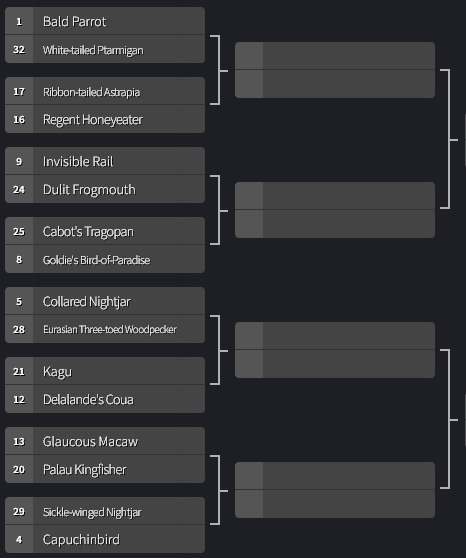
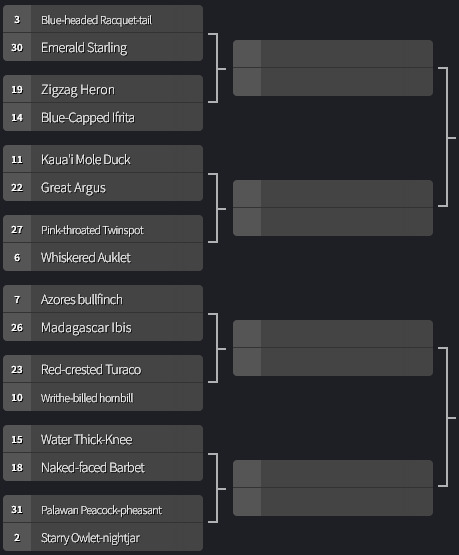

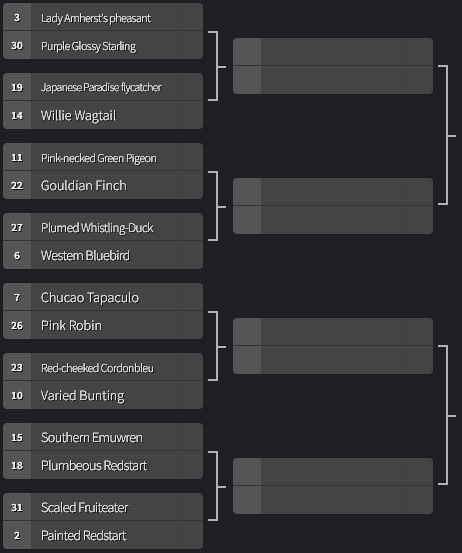
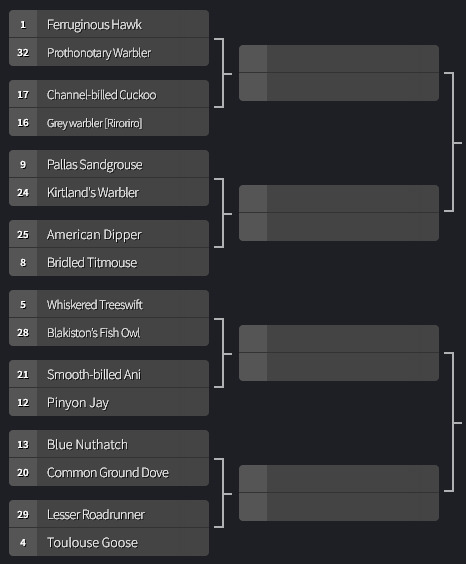
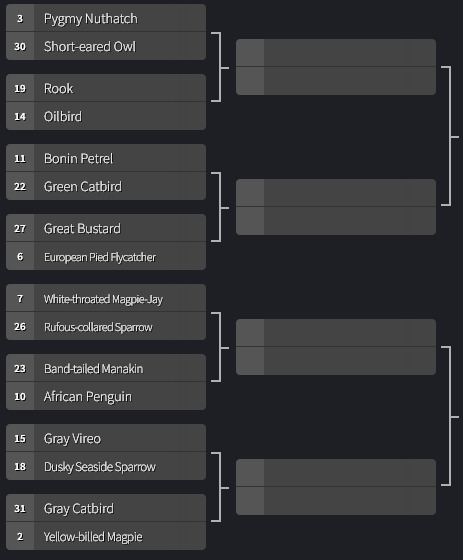

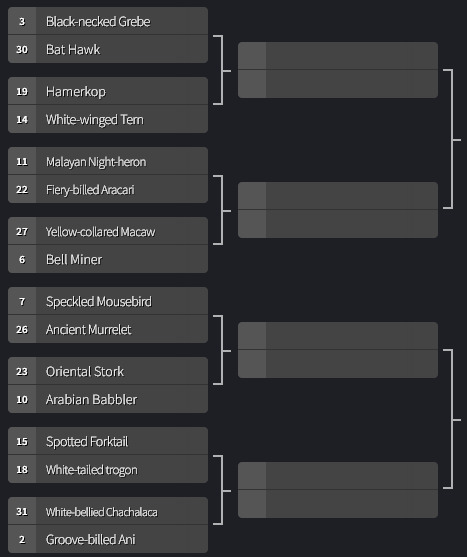
There are four brackets [Fave, Pretty, True, Four] comprising of 32 birds, for a total of 128 birds in this poll! I will reblog a version of this post with every bird listed via text within their bracket, so it is easier to find for those with image issues. It's gonna take a while to actually put the posts together for the first round, seeing as there are 64 battles happening, so expect the polls to go up around July 12th.
Below is a link for submitting any cool facts or info about the birds you want to win. It's not necessary to send info here, but I like to give the option to infodump about birds, and it helps with keeping things organized. As a heads up, the submission box is capped at one response only (with up to three birds in said response) just to keep things from getting cluttered.
As per tumblr etiquette, you are totally free to reblog the polls themselves with as much propoganda as you want. These submissions are just to help me fill the poll post with some cool facts.
54 notes
·
View notes
Photo

八哥 Crested Myna @afcdgovhk 八哥是喜歡群體活動的一種本地留鳥。牠們全身黑色而有光澤,前額有長冠羽,在飛行時會露出翼下兩片白斑,非常奪目。 Crested Myna is a resident bird which often appears in flocks. plumage is shiny black with long tufts on forecrown. they show distinctive white patches under each wing in flight. *資料來源:香港濕地公園網頁* *Resources from Hong Kong Wetland Park Website* 八哥喺香港受野生動物保護條例 (第170章) 保護。 Crested Myna in Hong Kong protected by WILD ANIMALS PROTECTION ORDINANCE (CHAPTER 170) #香港 #生態 #香港生態 #大自然 #香港大自然 #觀鳥 #香港觀鳥 #八哥 #離島區 #大嶼山 #梅窩 #afcdgovhk #CarmenKennyLukeYip #HongKong #Ecology #HongKongEcology #Nature #HongKongNature #BirdWatching #HongKongBirdWatching #CrestedMyna #IslandsDistrict #LantauIsland #MuiWo #afcdgovhk #CarmenKennyLukeYip(在 Mui Wo) https://www.instagram.com/p/ClqOUDFSeIX/?igshid=NGJjMDIxMWI=
#香港#生態#香港生態#大自然#香港大自然#觀鳥#香港觀鳥#八哥#離島區#大嶼山#梅窩#afcdgovhk#carmenkennylukeyip#hongkong#ecology#hongkongecology#nature#hongkongnature#birdwatching#hongkongbirdwatching#crestedmyna#islandsdistrict#lantauisland#muiwo
0 notes
Text
Day 2 of Maui vacation
I meant to post more [at all] about how the vacation is going. However, traveling with Wife is a very busy and active affair without much downtime for that. But I’ll try to post belatedly. So, here’s what happened on Day 2:
Birdwatching tour!
(below the cut, more detail than anyone besides @lies wants about the birds we saw and also what happened with the broken fridge in the condo)
There are only about 50 species one is likely to see on Maui, and we saw 29 of them, including some forest birds which I had particularly hoped to see.
Our guide picked us up around 7:30am. It turned out it was just us and the guide, even though we hadn’t paid for a private tour. Apparently everyone else who wanted to birdwatch last week had wanted to go on Tuesday, so we lucked out.
We started at Kealia Pond National Wildlife Refuge, which used to be a fish farm. We saw 15 bird species there, including a huge number of Hawaiian black-necked stilts, lots of Hawaiian coots, some hybrids of mallards with Hawaiian ducks, both of the doves we’d been seeing around town (spotted and zebra), a couple of wandering tattlers, a family of black-crowned night-herons, and a Java sparrow which was adorable and looked a little like a tiny puffin. On our way out we passed a gray francolin, which was introduced here for hunting.
On our drive up to Haleakala National Park, we saw lots of common mynas (they’re everywhere in Hawaii), as well as a Pacific golden-plover and 2 Eurasian skylarks, a pair of ring-necked pheasants, and a few chukars. I hadn���t realised how many kinds of game birds had been introduced here for hunting!
We went up to the summit (about 10,000ft (3055m)), but it was completely clouded in, so we couldn’t see the views of the crater or the ocean. But we did see some fascinating lava rocks and interesting plants (silversword), and the observatory buildings.
Then we drove down to about 7000ft and had lunch (luckily there was a shelter with a picnic table under it, as it was still a bit drizzly there) before walking a short foresty trail with a few points overlooking a gulch. Two nenes (the Hawaiian goose) flew past while we were eating. On the walk we heard, but didn’t see, a Chinese Hwamei and a Maui Alauahio (though we may have had a glimpse of the latter), and we saw a bunch of `apapanes and even more `i`iwis as well as the Hawaii amakihi (Maui subspecies). The `i`iwis kept chasing the `apapanes away--both are fairly spectacular red birds (endemic to Hawaii) that like to feed on red flowers. I was particularly excited to see the `i`iwi since it is on the cover of my Hawaii bird book!
The drive down the mountain was treacherous at first, but atmospheric--we were literally inside a cloud with very poor visibility! The final site was a golf course. We birdwatched from the van, driving slowly along the road and stopping whenever we saw anything interesting. The most exciting birds there were the Java sparrows (so many tiny puffins!), scaly-breasted munias, chestnut munias, and red-crested cardinals. We also saw a mongoose, which is worrying--they eat the nene eggs and chicks. Then the guide dropped us off at about 4pm. A long day!
Since then (just to include most of the birdwatching content in one post), I’ve also seen rosy-faced lovebirds (released/escaped pet parrots) and warbling white-eyes from the balcony of the condo we were staying in.
Disappointingly, the broken refrigerator in the condo didn’t get replaced because the old one couldn’t be removed due to being blocked in by the newish washer and dryer. The owners gave us a partial refund (less than 10%) in compensation but it was a real shame because the kitchen was otherwise very nice and we would’ve liked to cook our own meals some of the time. That night we ate out at a nice restaurant instead.
5 notes
·
View notes
Note
5 for Danbrey sfw? 3 would be fun for nsfw but idk if you do Danbrey nsfw
I decided to mush the two prompts together. I gave them saucy overtones, but they’re still SFW
5 Should I update my outfit again? I think they like my new boots but the cape didn’t get the reaction I was hoping for
3 Okay so when they wink at me after a great comeback, is that just their charismatic arrogance or do they maybe like me back?
“I think I should ditch the cape. I mean, she didn’t mention it all Cleopatra.” Dani sits down on the greenhouse bench to adjust her bootlace. Cleopatra tilts her head, curious, but does nothing else. This is because she is sentient venus flytrap and is limited in her ability to communicate.
“I did catch her checking out the boots. I think. Maybe she was just looking for a way to knock me off my feet.” She mists Cleopatra and her sisters, continuing, “which, also, she literally made a quip about wanting to sweep me off my feet. I just cannot get a read on her.”
She stands, walking to her devils-mouth orchids and checking their water levels, “I mean, I even picked fabric for the cape that made my eyes look nice. Jake helped me make sure the colors on the cape and the boots matched up and everything. Uggggggggh, I cannot believe it’s come to this.”
“Haha!”
“Not helping, Juice.” She turns to the Myna bird (one of three) perched on a nearby branch. They’re trained to be spies and minions, but mostly they offer unsolicited commentary on her life.
“Ask her.” Squawks another
“DON’T ASK!” Shrieks the third.
“Come to a consensus or I’m not putting that intelligence serum in your water anymore.”
The birds exchange a look.
“Don’t follow our advice!” says the smallest one.
“Don’t, don’t” echo the other two.
Dani sighs, turns back to Cleopatra, “Come on, help me figure out what to wear for the next time.”
The plant slithers along behind her (she modified the flytrap genome with anaconda DNA), curls up on the counter in the bathroom as she pulls out her make-up case.
“Okay, copper is good on the eyes right? It’ll highlight the gold. I think. Hmmmm…” she taps her chin with the end of a brush, “vampy red would definitely make her look at my mouth. Which is apparently a thing I want, because I am the worlds most cliche supervillain.”
Cleopatra rustles her tendrils sympathetically.
“But the red clashes with everything. Maybe a deeper color, oooh, the cute cashier at the coffee shop said this one looked good on me. I tried to think of something flirty to say back and just ended up complimenting her pompadour. God, why is villain me so much smoother than civilian me? Or is she even that any more?”
A vine pats her hand.
“Thanks girl. Now, having my hair up is safe for fighting, but does it make me too severe? Like, too dominatrixy? Or does the Lady Flame like that sort of thing? Uhg WHY DO I CARE?” She thunks her head onto the mirror.
“Half-twist?” The purple-crested Myna bird pokes it head in, cocking it’s head robotically.
“.....Perfect.”
---------------------------------------------
The Pine Guard has once again gotten the drop on the Crystal Cabal, much to Dani’s annoyance. What is the point of having a team mate who can see the future if this keeps happening to them?
She dives out of the way of a burst of flame, tossing a handful of her latest creation at her nemesis.
“Aw, flowers for me?” Lady Flame flutters her eyelashes, “they’re prettyYYYow, fireflower.”
“That’s right, I turned your own element against you.”
The hero picks up the flaming flowers and starts juggling them, “I’ve heard of hothouse flowers, but this is ridiculous.”
“She’s flame-proof, Demeter, for goodness sake, OW that hurt.” Indrid, aka Nyx, throws a punch at The Ranger, who absorbs the blow easily.
Dani hadn’t been thinking of flame proof heroes when she made the plants; she’d been thinking what color to make them so that the Lady Flame would think they were pretty.
“If you all would kindly just surrenderPUT ME DOWN!” The Agent yelps, indignant, when Barclay, aka Hermes, hoists him over his shoulders.
“And if you’d ‘kindly’ just hold still and not bother us for ten minutes, this could all be avoided.”
The fireflowers turn to ash, Lady Flame stepping through it with a grin, “I dig the new boots, very classy. Got a whole ‘don’t fuck with me vibe’ I like a lot.”
“That’s exactly what you should have done. You should have left us alone.” Dani musters her most imperious voice as she launches vines across the ground, taking Lady Flame by surprise and trapping her in the grasp of two large, green, fireproof tendrils.
“Hah! Surrender, all of you, or my pets will-”
“Eeeep! Hey, what the-” The Lady Flame looks behind her at the smaller vine that just pinched her butt.
“Ohmygosh, I’m so sorry-”
“C’mon now Demeter, no need to get fresh with her. That ain’t sportin.”
“That’s rich coming from the man currently straddling me.” Indrid hisses.
“I ain’t straddlin, I’m restrainin.”
“I mean I, whoah, hey there” another vine caresses Lady Flame’s chest, a third touches her cheek, “I’m not, like, opposed to someone getting handsy, or uh, viney, I guess. But you have to buy me coffee first.”
“I’m, I don’t know why they’re doing this. I’m so sorry, they’re being so rude and they will be mulch if they touch you in a way you don’t like.” Dani takes one step forward and a vine grips her ankle, starts twining upwards.
“Uhhhhh, why are they doing that?”
“They shouldn’t be! They respond to my thoughts and emotional state.” She tries every trick she can think off, but nothing makes the vines obey, and two more encircle her chest and stomach.
“Wait, if they respond to your feelings, then do you-GAH!” The vine around Lady Flame’s ribs visibly tightens, as the ones holding Dani drag the two women face to face.
“I’ve always thought you were breathtaking, but the literal approach is kinda freaking me out.”
“Me too.” Dani thrashes, and the vine tightens around her. She’s starting to get lightheaded.
“Guys, a little-”
“-Help!” Dani finishes the Lady Flames’ sentence, and the four other figures in the room turn towards them as one.
“Oh shit.” Barclay tosses The Agent away, drops down next to Dani, hacking at the larger vine with his utility weapon. The Agent recovers, tries to yank the main vine from it’s source only for a tendril to whip out and strike his cheek.
“I would like it noted that this was not a likely future.” Indrid tugs at the tightest vine, slashing it with his sharp nails. The Ranger manages to rip one off of Lady Flame’s arm, only for it’s larger cousin to shoot out, sending him flying into Indrid and knocking them both to the ground.
As their teammates continue their losing battle against her unfortunately durable creation, Dani turns to meet her enemies eyes.
“I’m sorry.” She whispers, “I never really wanted to hurt you. I just wanted you all not to hurt us.”
“I mean we, like, don’t hate you all or anything, but you’ve, like, been putting people in danger, and blowing things up-”
“Nyx didn’t blow up that bridge!” If they’re both about to die, there’s no point in keeping up the act.
“Wait, what?”
“He was framed, but we thought it made people take us seriously as a threat, listen to us, so we let people believe it was true. Same with me and that power plant. I just blackmailed the CEO into admitting they’d been dumping toxins in the water supply. None of us blew the place up. Hell, you guys were the ones who destroyed that factory.”
“.....wait, they told us you did that.”
“Who told you?”
“Them? Y’know, the big bosses?”
“We don’t have those, but we do have informants.”
“What the fuuUUUCk, ow, squishing my ribs, we’re being played.”
“That, ow, that sucks. All this time we’ve been fighting, we could have been dating, I mean, uh, working together.”
Lady Flame laughs, a bright, beautiful sound, “I knew you were checking me out.”
“Me?! You were the one who kept making flirty comments.”
“Hey, banter’s part of the job. Also, you have a cute butt and that costume really shows off your, um,” The last word is so quiet Dani can’t make it out, but given that Lady Flame glances at her chest, she’s got a good guess as to what it was.
The vines constrict and they both hiss in pain, the world going fuzzier at the edges as breathing gets almost impossible.
“I, if this, if this is the end, I just wanna say it’s been a pleasure doing battle with you, Lady Flame.”
Fire colored eyes meet her own, accompanied by a weak smile, “You can call me Aubrey.”
“Dani. Nice to meet you, Aubrey.” She has just enough energy to tip her head forward, bringing their lips together. It’s barely a kiss, but as soon as they connect the vines go limp, dropping them to the floor.
For a moment they gasp jointly for air, then Aubrey is in her lap, fingers tangling in her hair as she kisses her hard and happily. Dani sighs into the kiss, melting into the embrace, knowing full well the near-strangulation isn’t what’s causing the dizziness in her vision and the butterflies in her stomach.
“Uh, can’t help but feel we missed somethin.” Over in the corner where they were both thrown (twice), The Ranger tries to disentangle himself from Indrid, who sits up with a knowing look.
“Oh, I see. It appears we are about to form an alliance.”
“Really?” Barclay looks back at them from where’s hes sitting, checking the cuts on The Agents face.
“It’s a long story, but the cliff notes are: we’re pretty sure someone’s been setting us against each other on purpose. Making us each think the other caused certain disasters.”
“Which means it’s time for a team-up.” Aubrey cracks her knuckles, sending sparks flying. Then she glances shyly at Dani, who reaches out to brush stray ash from her cheeks, “Um, but before that, would you like to go out with me?”
Dani kisses her again, bumps their noses together with a smile as she murmurs, “That sounds really fucking awesome.”
26 notes
·
View notes
Text
Inner-city Bird Diversity
Birds on our Balconies
We live in a small high-rise on the edge of the Melbourne CBD, on the lowest level of apartments, 6 floors above street level. We are on the intersection of two heavily trafficked streets, with constant construction and traffic noise all day and most of the night. We have two outside terraces and despite the noise and pollution, we have been visited by many birds over the years we have lived here. The list of 19 species that we have seen on our terraces is as follows:
Common Blackbirds
Grey Butcherbirds
Pied Butcherbirds
Sulphur-crested Cockatoos
Pied Currawongs
Rock Doves (Feral Pigeons)
Spotted Doves
Galahs
Silver Gulls (ubiquitous Seagulls)
White-plumed Honeyeaters
Australian Magpies
Magpie-larks
Common (Indian) Mynas
Little Ravens
House Sparrows
Common Starlings
Song Thrush (barely-fledged chick – no idea how it got there)
Red Wattlebirds
Domestic chicken (presumed escapee from a higher apartment in a nearby tower)
In addition, I have also seen regular flypasts by several of the above species as well as four more that have not actually landed on our terraces:
Peregrine Falcons
Nankeen Kestrels
Masked Lapwings
Rainbow Lorikeets
Birds nearby
Most people imagine that big cities are virtually devoid of wildlife and what there is, is limited to cats, dogs, rats, mice, sparrows and seagulls. But landings and sightings from our apartment, less than a kilometre from the centre of the city, number 23 species and I have seen at least another 15 on my walks across the Yarra into the CBD. They include:
Eurasian Coots
Little Black Cormorants
Little Pied Cormorants
Great Cormorants
Darters
Pacific Black Duck
Nankeen Night-herons
White-faced Herons
Australian White Ibises
Australian Pelicans
Welcome Swallows
Black Swans
Chestnut Teal
Grey Teal
Crested Terns
I do quite a lot of bird surveys and within a further kilometre of home, I have reported personal sightings of at least the following 41 additions.
Red-tailed Black-Cockatoo
Long-billed Corella
Black-faced Cuckoo-shrike
Black-fronted Dotterel
Red-kneed Dotterel
Maned Duck (Australian Wood Duck)
Pink-eared Duck
Great Egret
Superb Fairywren
Grey Fantail
European Goldfinch
Australasian Grebe
Hoary-headed Grebe
Common Greenfinch
Pacific Gull
Hardhead
Swamp Harrier
New Holland Honeyeater
Sacred Kingfisher
Eastern Koel
Musk Lorikeet
Bell Miner
Noisy Miner
Dusky Moorhen
Spotted Pardalote
Red-rumped Parrot
Little Penguin
Crested Pigeon
Red-capped Plover
Australian Reedwarbler
Crimson Rosella
Sharp-tailed Sandpiper
White-browed Scrubwren
Silvereye
Grey Shrike-thrush
Royal Spoonbill
Yellow-billed Spoonbill
Pied Stilt
Australian Swamphen
Willy Wagtail
Little Wattlebird
Who would have thought I could possibly have seen 79 different species of urban birds within a kilometre of Southbank – in an area of less than 4 square kilometres? Other people have obviously seen other species as well, so maybe this figure might be closer to 90 species. The landscape is certainly not barren, but I am lucky. I live close to large areas of saltwater, freshwater, marshland, luxuriant parks and gardens with a good range of habitats for so many species. Away from this area, the variety and abundance of wildlife is rarely as prolific.
2 notes
·
View notes
Text
Characters of the Farlands - Kite

Common Name: Kite
Farspeak Name: Akähani Fahimro
Name Meanings:
Kite - A graceful predatory bird Akähani - One who watches from above, intelligent hunter Kähiro - A fond nickname given to her by her parents
Homelands: The Stretch
Current Lands: Clan Wards
Allegiance: The Searsband, The Five Clans Sanctuary
Classification: Charmer (Sear) - Summoner/Charter
A silver charcoal, seal mink-lynx point classic molly with a white muzzle, four white paws and a white crest around her eyes. Kite’s nose and paw pads are a dark gray with her pads being tough and trained for long travels. With piercing aqua blue eyes and slightly longer neck fur, Kite is a real sight for sore eyes.
Kite has grown up with danger and death around every corner as a third brother. She’s watched cats fail their summoning exams and be immolated from the inside, screaming as their fur bakes to their skin as they spit up blood. She’s watched guards be dragged shrieking into the woods during the night with only cracked skulls and smeared splotches of blood to their names. As such, she’s rather casual and offhanded about death and gore - practical in a sometimes insensitive way.
Kite became a charter rather unwillingly - the destruction of the searsband forced her family from their home grounds and into the stretch as a whole. To her surprise, Kite learned that she thrived in this kind of environment where she never knew what was lurking behind the next set of trees. She learned that having a safe place to retreat to when she needed to but having the option to live on the wide-opened stretch reassured her.
Dame: Argent
Sire: Tanager (Deceased)
Parent(s): Argent and Tanager
Sibling(s): Myna (sister), Rusty (brother), Fawn (brother/MIA), Chestnut (deceased), Ivory (sister/deceased)
Mate(s): Whisper
Kit(s): Whistle (adopted daughter), Flicker (adopted daughter)
#characters of the farlands#the farlands#the farlands au#projects by ankh#warrior cats#warrior cat au#warrior cat ideas#warriors#kite
1 note
·
View note
Text
2020
Part of me wants to say that 2020 was just a terrible year. And in some ways it was. But I can’t ignore that in so many ways it wasn’t. In the macro, it was, for the most part, a pretty terrible year. It was a year of frustration and anger and disillusionment and violence and disappointment. I fear that it is a year that will have long-lasting and far-reaching repercussions. But in the micro, I am blessed to say that I was not too affected by the situation. I know that I could have and should have conducted myself with more grace and patience this year. I let my anger and frustration and worry take a hold of me and I took it out on those around me. But when I put aside those emotions, I can appreciate all the blessings I received.
I am grateful for all the unexpected time I got to spend with family this year. I am so grateful for the seven months I spent with Mom. Probably the last time we’ll ever live together again and maybe the closest we’ll ever be. I am grateful for that strange spring and that loooong summer that in some ways doesn’t feel like it happened at all. I am grateful for watching the sun rise most mornings from the sunny little office that I painted yellow. Watching the first wisps of pink crest the hill and illuminate the dew on the lawn and the grey cat on the fence and the roses blossoming on the bush in the back corner of the garden and the downy white blooms on the crepe myrtles. I am grateful for the chill of the hardwood floors in the morning and the baking heat as the sun shone full through the windows in the afternoon. I am grateful for calling to Rosie through the thin, warped glass windows as she lay on the deck or sniffed under the gate. I am grateful for Friday Facetime sessions with Ngawang. Sitting in the sweltering office and talking about nothing and everything. Making plans for future trips and lamenting what the world had come to. I am grateful for sitting on the top step in the afternoon when I was finished with work. Listening to Genesis or Leviticus, drinking strawberry milk or eating berries or an acai bowl, the sun browning my back and Rosie coming to sit beside me, nudging her head under my arm. I am grateful for throwing the Frisbee with her and playing keep away and running around the back yard under blindingly blue afternoon skies or beneath pale pink and purple sunsets as the crows squawked and returned to their roosts in the tall trees on the ridge.
I am grateful for my morning chats with Mom. Walking into her room once I finished my morning meetings, and commiserating about the news and laughing about our lack of plans and lamenting her empty retirement and complaining about my boss and talking about the neighbors who passed by on their morning walks and boxing with Rosie as she lay at the end of the bed. I am grateful for afternoons on the front porch, watching the little world go by on C Street, joking with Steve and Bill, playing American Trivia, reading languorous novels while Mom read the paper, looking at houses on Zillow and whiling away the long afternoon hours. I am grateful for weekend mornings at the dog park. For walking up the hill in invariably inconvenient shoes then sitting high on the bench at Gerstle Park as Rosie trudged through the ivy and did her looping patrol of the hillside. Or sunny, windy days at Mill Valley Park, watching dogs reluctantly run the agility course or race across the broad lawn after a ball or Frisbee or dive unhesitatingly into the muddy shore of the bay. And I am so grateful for mornings at Piper Park. Sitting on our favorite bench beneath the thin maple, looking out across the verdant lawn at Mt Tam standing sentinel over us with Hall nestled in the middle ground where I spent so many hours playing soccer or sitting in a circle with my friends in the back corner of the field or laughing over our lunches at the picnic tables. I am grateful for the familiar faces at the park, the people whose dogs’ names we knew but not their own. I am grateful for iced chai’s sipped on the park bench as mom and I talked about our school days while Rosie lay panting in the tall grass behind us in the shade of the great willow tree looking out at the high creek.
I am grateful for our afternoon drives when there was nothing else to do. For the chance to explore Marin. Driving down Center Street through sleepy Fairfax and over the hill to San Geronimo. Cows and granite boulders and scraggly trees dotting the fields that crept up the hillsides as hawks circled overhead. I am grateful for that long, straight road through that wild, wonderful country. I am grateful for the shaded windy road through the redwoods towards Nicasio and the little white school house on the corner. I am grateful for the backroads towards Petaluma past the Nicasio Reservoir with hills so vibrantly green and rolling and tranquil that I was reminded of Ireland. I am grateful for the turn onto Petaluma Road and the lazy bends up the hill with sudden vistas of the valley below. And I am grateful for the 37 towards Sonoma and Napa, for the horses on the hill and the bridges over the bay and the beached boat on the side of the road and the long low lane through the marshes. And I am grateful for all the laughs and talks we had during those drives while bluegrass and rap and oldies and classic rock played on the stereo. I am grateful for afternoons at Stinson and Rodeo when we could forget the wider world and enjoy the simple beauty that California still has to offer as we watched dogs and children frolic in the surf and dig in the sand.
I am grateful for my trip with Michelle and Dash. For honky tonk country music and long lazy drives through the central valley and the sunshine in LA and the quiet of Utah and the vastness of the sky and the rainbows of Bryce Canyon and the awe-inspiring beauty of Zion and the blinding white of the Booneville Salt Flats and the gaudiness of the Las Vegas Strip and my grueling hike with Dash and our long talks on the road or in the evening. I am grateful for the time I got to spend with Michelle. For our tours through the City and the East Bay, spending the whole day exploring and talking and complaining and laughing, agreeing on so much. For our dinner on New Year’s Eve, driving to a hilltop in South SF and eating dumplings out of to-go containers and exchanging Christmas gifts and trying to make sense of the craziness of this year. I am grateful for the time I got to spend with her family. At her niece’s birthday party while the children splashed in the pool and her dad told me about Nauru. And at Samuel P Taylor as we sat around the campfire and sang Russian and Slovakian folk as Steve strummed along on the guitar. And at Labor Day weekend with Mom, eating hotdogs with Michelle’s parents under the sprawling oak in their backyard and seeing Lenka and Janka and Kimmie and Alex. Mom and I talking on the way home about the unique sadness of being an only child and the joy that a big family brings.
And I am grateful for my three trips to Hawaii this year. And especially for this last one. I am so grateful for cool mornings on the lanai, watching the shadows recede across the lawn and the sea lighten from grey to blue in the morning sun, the myna birds stirring and shrieking, me slowly drinking my guava juice while reading or embroidering and then sitting with Dad and talking about movies and psychology and ideas for articles and albums. I am grateful for morning walks on the beach, for the dogs and the surfers and the damp sand and flip-flops left in the shade and the waves creeping up the shore. I am grateful for lunches on the lanai or at Hula or Mama’s. For the tropical rainstorm at Hula Grill as I drank my strawberry daiquiri and for the light rain at Mama’s as the colossal waves crashed against the coast. I am grateful for drives along the seaside while music played, with the multi-hued ocean to one side and the steep, sculptured mountains shrouded in fog on the other. I am grateful for lazy afternoons napping and reading and playing trivial and scrabble and cards. For time to be together and relax. I am grateful for home cooked meals, the three of us joining hands around the table for grace and piling the plates to one side to talk after we’ve finished eating. I am grateful for our dinner at Spago’s, watching the sun set behind the palms and the lights illuminate the beach, sharing sushi and keeping an eye out for celebrities. And I am grateful for nights after dinner watching good movies and bad. Talking through plot points, arguing about Gal Gadot’s attractiveness, predicting the storyline of Soul, and marveling at the athleticism of Gene Kelly. I am grateful for the warmth and beauty and slowness of Maui.
I am grateful for the breath-taking sunset that I saw from the plane last night, the sun dipping down into the Pacific and bathing the hills of Pacifica in gold while the city sparkled farther north. I am grateful for the sunrise I saw today from the back of an Uber on the New Jersey Turnpike, the sky confetti pink and yellow, silhouetting the Manhattan skyline across the Hudson.
This has been a hard year. A trying year. But a year for growth and reflection and pause. A year that threw most of my goals and hopes out the window but that gave me so many other blessings in return. This was the first year since 2013 that I did not leave the country. I got to spend 365 days in the country that I love so much and I got to explore new parts of it and fall in love with it more even as I worry over its future. I spent every holiday this year with people I love, Fourth of July with Dad and Susan, my birthday with Mom and Ray, Thanksgiving with Ngawang and Aja and Deanna and Abina and Ritcha and Christmas and New Year’s with Dad and Susan and Mom and Michelle. I must admit that I am glad that 2020 is over but I am thankful that I lived it.
0 notes
Photo









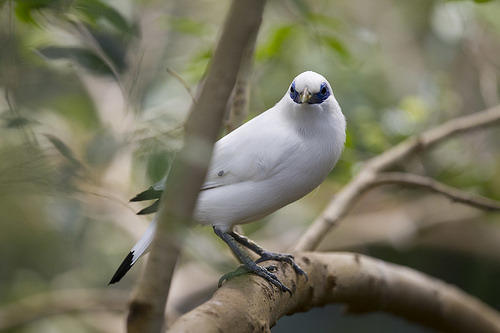
Jalak Bali
The Bali myna is a medium-large bird, almost wholly white with a long, drooping crest, black wing-tips and tail tip. It has a yellow bill with blue bare skin around the eyes and legs. The Bali myna is restricted to the island of Bali in Indonesia, where it is the island's only endemic vertebrate species. The bird was discovered in 1910, and in 1991 was designated the faunal emblem of Bali, its local name is jalak Bali.
The Bali myna is critically endangered, and the wild population has been close to extinction since at least 1994. As of 2015, less than 100 adults are assumed to exist in the wild, with about 1,000 believed to survive in captivity. Trade even in captive-bred specimens is strictly regulated and the species is not generally available legally to private individuals. The number of captive birds bought on the black market is estimated to be twice the number of legally acquired individuals in the captive breeding programs. During the 1990s over 400 cage-bred birds were released into the park to increase their numbers. But by 2005, the park authorities estimated the number to have fallen to less than 10. This decline was caused primarily by poachers responding to the lucrative demand for rare birds in the caged bird market.
In its natural habitat it is inconspicuous, using tree tops for cover and usually coming to the ground only to drink or to find nesting materials; this would seem to be an adaptation to its noticeability to predators when out in the open. The Bali mynah often gathers in groups when it is young to better locate food and watch out for predators. The Bali myna's diet includes fruit, seeds, worms and insects. The birds nest in tree cavities, with the female laying and incubating two or three eggs. Both males and females bring food to the nest for chicks after hatching.
2K notes
·
View notes